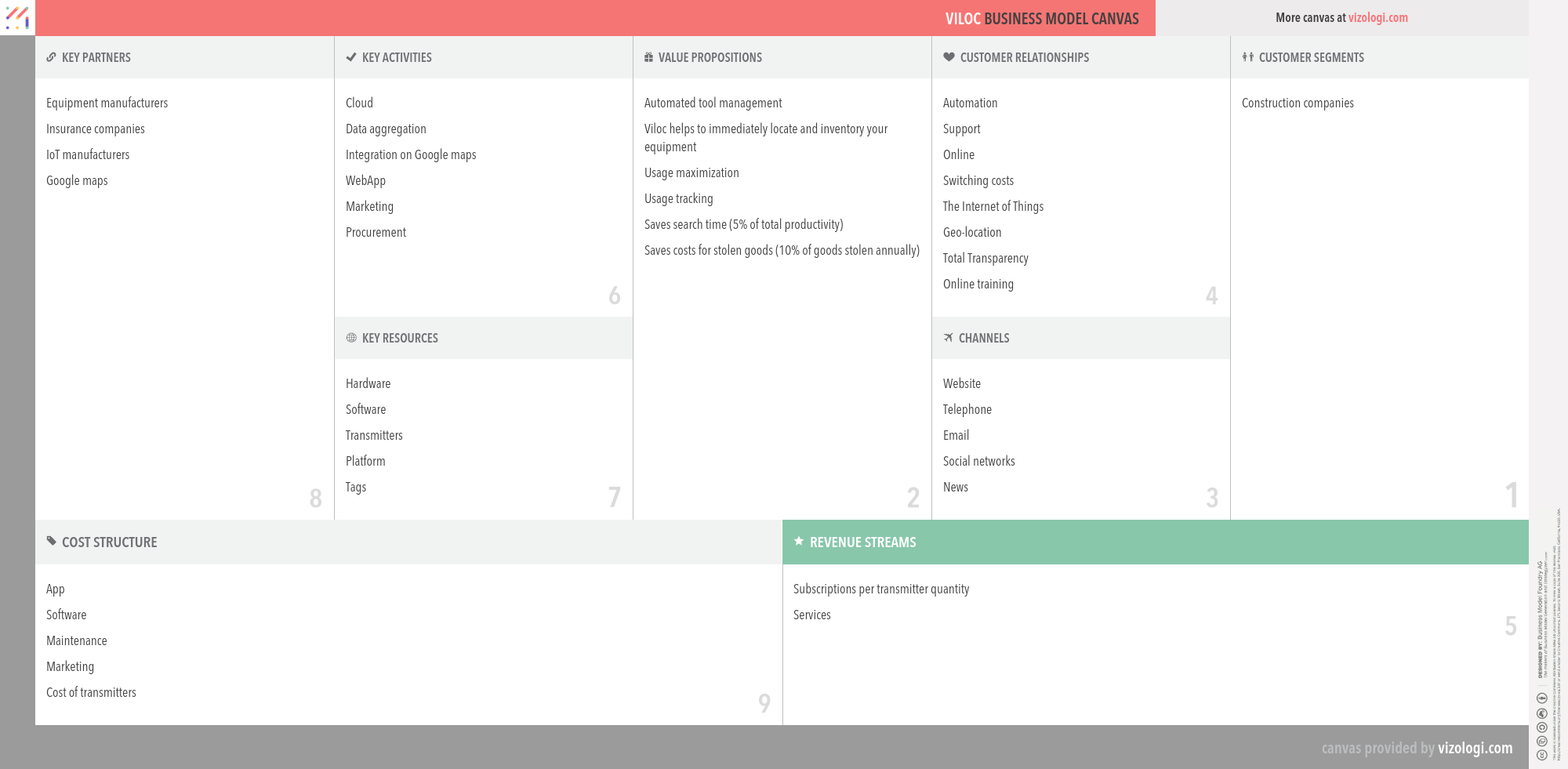Why Viloc's Business Model is so successful?
Get all the answers 
Viloc’s Company Overview
Viloc is a company automating tool management for the construction industry. By placing a handy little transmitter on all the equipment of a construction company, the equipment is directly linked to a web application at their office.
http://www.viloc.eu/Country: Belgium
Foundations date: 2010
Type: Private
Sector: Technology
Categories: Construction
Viloc’s Customer Needs
Social impact:
Life changing: affiliation/belonging
Emotional: reduces anxiety, rewards me, badge value, provides access
Functional: simplifies, makes money, reduces costs, informs, reduces risks, saves time, avoids hassles, integrates, organizes
Viloc’s Related Competitors
Viloc’s Business Operations
Augmenting products to generate data:
Due to advancements in sensors, wireless communications, and big data, it is now possible to collect and analyze massive quantities of data in a wide range of settings, from wind turbines to kitchen appliances to intelligent scalpels. These data may be utilized to improve asset design, operation, maintenance, and repair or improve how an activity is carried out. Such skills, in turn, may serve as the foundation for new services or business models.
Codifying a distinctive service capability:
Since their inception, information technology systems have aided in automating corporate operations, increasing productivity, and maximizing efficiency. Now, businesses can take their perfected processes, standardize them, and sell them to other parties. In today's corporate environment, innovation is critical for survival.
Consumerization of work:
Consumerization of IT (consumerization) is a term that refers to the process by which Information Technology (IT) begins in the consumer market and then spreads to business and government organizations, primarily as a result of employees utilizing popular consumer market technologies and methods at home and afterward bringing them in the workplace.
Digital:
A digital strategy is a strategic management and a business reaction or solution to a digital issue, which is often best handled as part of a broader company plan. A digital strategy is frequently defined by the application of new technologies to existing business activities and a focus on enabling new digital skills for their company (such as those formed by the Information Age and frequently as a result of advances in digital technologies such as computers, data, telecommunication services, and the World wide web, to name a few).
Direct selling:
Direct selling refers to a situation in which a company's goods are immediately accessible from the manufacturer or service provider rather than via intermediate channels. The business avoids the retail margin and any extra expenses connected with the intermediaries in this manner. These savings may be passed on to the client, establishing a consistent sales experience. Furthermore, such intimate touch may help to strengthen client connections. Finally, direct selling benefits consumers by providing convenience and service, such as personal demonstrations and explanations of goods, home delivery, and substantial satisfaction guarantees.
Product innovation:
Product innovation is the process of developing and introducing a new or better version of an existing product or service. This is a broader definition of innovation than the generally recognized definition, which includes creating new goods that are considered innovative in this context. For example, Apple launched a succession of successful new products and services in 2001?the iPod, the iTunes online music service, and the iPhone?which catapulted the firm to the top of its industry.
Software as a Service (SaaS):
Software as a Service (SaaS) is a paradigm for licensing and delivering subscription-based and centrally hosted software. Occasionally, the term on-demand software is used. SaaS is usually accessible through a web browser via a thin client. SaaS has established itself as the de facto delivery mechanism for a large number of commercial apps. SaaS has been integrated into virtually every major enterprise Software company's strategy.
Tag management:
Tag management refers to the capability of the collaborative software to handle both your own and user-generated tags. Marketers use various third-party solutions to enhance their websites, video content, and mobile applications. Web analytics, campaign analytics, audience measurement, customization, A/B testing, ad servers, retargeting, and conversion tracking are examples of such systems. At its most fundamental level, tag management enables new methods for your business model to use data.
Recommended companies based on your search:

